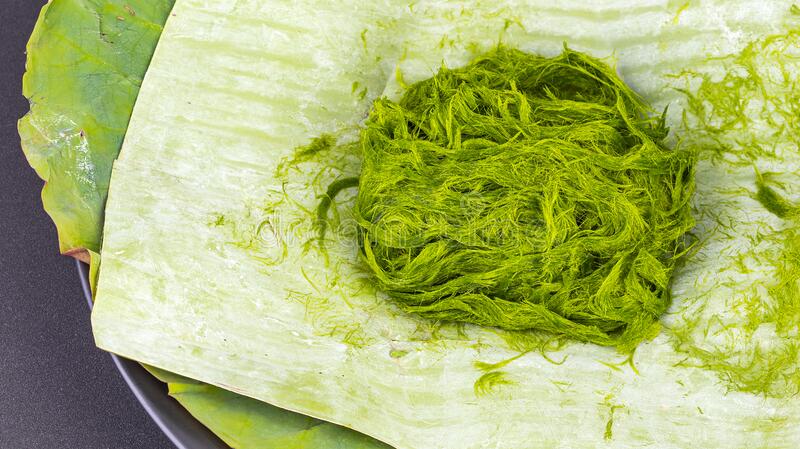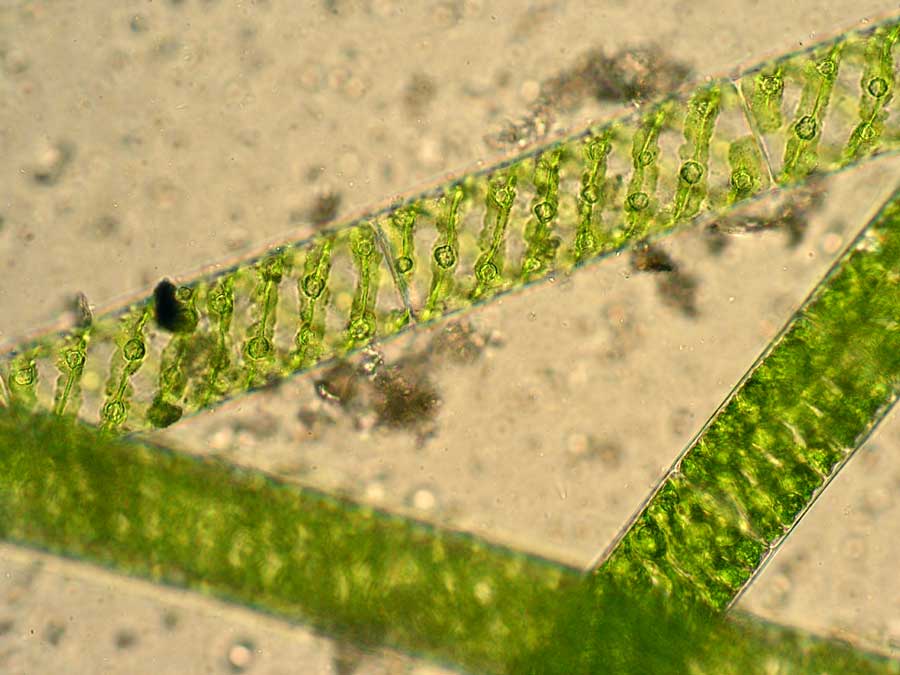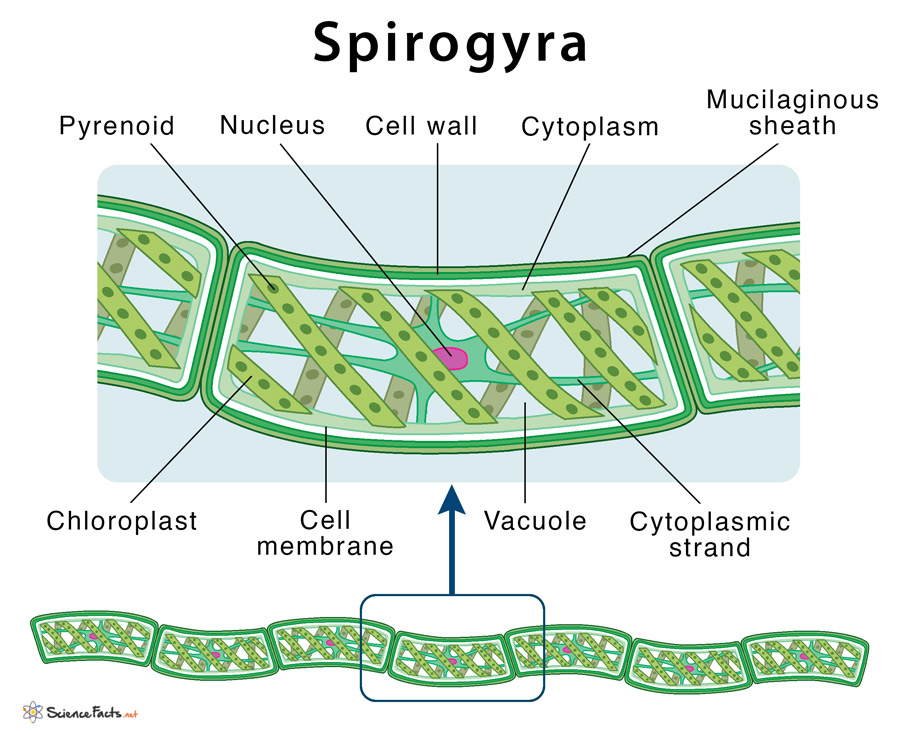Spirogyra
What is Spirogyra
Spirogyras, commonly known as blanket weeds, water silk, or mermaid’s tresses, are multicellular, free-floating algae that are commonly found to live in fresh water habitats such as ponds, pools, tanks, lakes, and stagnant waters. They are also known as pond scum or pond silk because of their filamentous and slimy nature that can float freely in masses over the water surfaces and are capable of movement. There are around 400 species of Spirogyra found worldwide. The name ‘Spirogyra’ is derived from the Greek words, ‘speria’, meaning coil, and ‘gyras’, meaning twisted.
Scientific Classification
| Domain | Eukaryota |
| Kingdom | Plantae |
| Phylum | Chlorophyta |
| Class | Zygnematophyceae |
| Order | Zygnematales |
| Family | Zygnemataceae |
| Genus | Spirogyra |
Structure
Size and Shape
The vegetative structure or plant body of Spirogyra is known as thallus. The thallus is un-branched and filamentous shaped, measuring approximately 10 to 100 μm in width and may grow up to several centimeters in length. Under a light microscope Spirogyra is seen as long threadlike, green colonies called filaments that are joined end to end, without any differentiation into base and apex.
Parts and their Morphology
- Cell Wall: Consists of three layers of which the inner two layers are made of pectin, and the outer layer is composed of cellulose. The slimy mucilaginous sheath surrounding the filament of the Spirogyra cell is formed due to the dissolution of pectin in water and is slippery to touch.
- Cell Membrane: Situated just beneath the cell wall, it is selectively permeable in nature that protects the inner cell content from the outside environment.
- Cytoplasm: The fluid that is mostly distributed to the periphery of the cell, forming a thin lining along the cell wall. It contains most other organelles that are usually found in higher animals such as endoplasmic reticulum, Golgi bodies, mitochondria, ribosomes, and other cytoplasmic inclusions.
- Vacuole: A centrally located large organelle that is filled with fluid, and maintains the water and salt balance inside the cell. The vacuole is separated from the surrounding cytoplasm by a semi-permeable membrane called tonoplast.
- Chloroplast: A ribbon-shaped organelle that is arranged spirally with serrated or smooth edges. It contains the green pigment chlorophyll that helps them to perform photosynthesis for producing their own food. There are approximately 1 to 16 chloroplasts present in a typical Spirogyra cell. A dense, highly refractive, granular protein body called pyrenoids is found within the chloroplast at very short intervals. Pyrenioids helps the cell to store starches and proteins, also providing a distinctive identifiable feature to Spirogyra.
- Nucleus: A membrane-bound organelle that contains the genetic material of the cell. The nucleus resides at the center of the cell, being supported by the cytoplasmic strands. It also contains a distinct nucleolus that helps the cell to synthesize proteins.
Characteristics
How do Spirogyra Move
Spirogyra forms long filaments that are capable of bending and curving, enabling locomotion. They move slowly in the liquid medium and are also capable of orientation towards light.
How do They Respire
Similar to plants, during daytime Spirogyra takes in carbon dioxide dissolved in water to release a relatively large volume of oxygen using specialized cells called stomata. The released oxygen remains trapped as tiny bubbles between the tangling strands of their filamentous body that helps them to float in water and become visible as a slimy green mat. At night and on overcast days, the process reverses, as Spirogyra consumes oxygen and produces carbon dioxide as a metabolic waste product of cellular respiration.
What do They Eat
Although they thrive to grow in nutrient-rich environments, Spirogyra produces their own food using the green pigment chlorophyll and sunlight through photosynthesis, thus performing an autotrophic mode of nutrition.
How do Spirogyra Reproduce
Broadly they perform three modes of reproduction that are described below:
Vegetative Reproduction
It occurs mainly by a process called fragmentation. Under favorable conditions of growth, the walls of adjacent cells dissolve, thereby causing breakage of the filament. After fragmentation, the vegetative filament develops into a new filament where each fragment undergoes multiple division and elongation to form a new filament. When a Spirogyra filament attains considerable length, it breaks into smaller pieces that can grow into a mature organism. Fragmentation is also found to occur due to a mechanical injury or a change in their aquatic medium’s salinity and temperature.
Asexual Reproduction
During unfavorable growth conditions, the cytoplasmic content of the cell shrinks and looses water, developing a hard covering around the cell, resulting in the formation of spores. Depending upon the thickness of the cell wall and their ability to move, spores in Spirogyra can be of three types – aplanospores (thin-walled and non-motile), akinetes (thick-walled and non-motile) and azygospores (thin-walled and motile). While akinetes and aplanospores develop into a new filament under favorable conditions after the decay of the parent filament, azygospores fail to fuse during sexual reproduction and develop into a new filament asexually. Asexual reproduction is thus a form of adaptation in Spirogyra.
Sexual Reproduction
It occurs during favorable conditions of growth through a process known as conjugation. It is of two types:
a) Scalariform Conjugation: Here the two participating cells or gametes with a haploid number (n) of chromosomes come in close contact and develop a small tube-like structures called papillae that fuse to form a bridge connecting the two cells known as conjugation tube. The male gamete squeezes through the conjugation tube and gets passed into the female gamete thus forming a diploid chromosome structure (2n) called zygote. A single zygote produces multiple thick-walled diploid cells called zygospores, which under the suitable condition of growth, form new filaments.
b) Lateral Conjugation: It occurs between the cells of the same filament. Lateral Conjugation is of two types:
- Indirect Lateral Conjugation: Here the male gamete moves through the conjugation tube and gets fused with the female gamete, forming a zygote or zygospore, which then develop into new filament.
- Direct Lateral Conjugation: It is a primitive type of conjugation where the entire cytoplasmic content of the male gamete migrates through the pore and gets fused with the female gamete forming zygospore, which later develops into new filament under suitable conditions.
Thus the sexual life cycle of Spirogyra describes the interchange between the only diploid-phased (2n) zygospore and the haploid phased (n) filamentous cells.
Biological and Economic Importance
- Sustaining marine life by releasing oxygen in water bodies, since most aquatic organisms need oxygen to survive.
- Helping to continue specific biogeochemical cycles in nature such as carbon and oxygen cycle.
- Acting as an essential food source for humans since they provide a rich source of nutrients including vitamin A and E. Spirogyra can be easily cultivated in the laboratories that helps in scientific researches.
- Providing a source of natural bioactive compounds that contains antibiotic, antiviral, antioxidant, anti-inflammatory, and cytotoxic properties.
- Acting as an ideal food source for many aquatic animals that feed on Spirogyra to get nutrition. It can also be used as aquarium fish-food.
- Serving as ornamental plants in the garden and thus helpingin beautifying the environment.
Along with the above, they may have a few mild negative impacts as well. For example, although no such serious diseases are found to be caused by them, it can spoil drinking water, and also its abundant growth in the water bodies can cause nuisance in swimming and fishing.
-
References
Article was last reviewed on Thursday, February 2, 2023







I really like the website